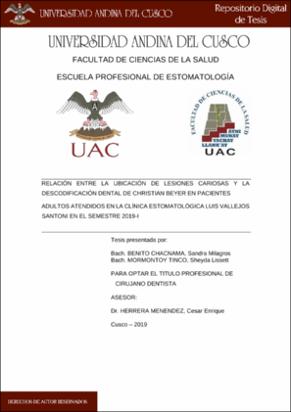| dc.contributor.advisor | Herrera Menéndez, César Enrique | |
| dc.contributor.author | Benito Chacnama, Sandra Milagros | |
| dc.contributor.author | Mormontoy Tinco, Sheyda Lissett | |
| dc.date.accessioned | 2019-12-19T16:17:10Z | |
| dc.date.available | 2019-12-19T16:17:10Z | |
| dc.date.issued | 2019-10-03 | |
| dc.identifier.uri | https://hdl.handle.net/20.500.12557/3161 | |
| dc.description.abstract | El presente trabajo de investigación tuvo como objetivo determinar la relación
entre la ubicación de lesiones cariosas por cuadrante y la descodificación dental
de Christian Beyer en pacientes adultos atendidos en la Clínica Estomatológica
Luis Vallejos Santoni. El tipo de estudio es Relacional-descriptivo de enfoque
cuantitativo, teniendo una muestra de 142 pacientes adultos que cumplieron con
los criterios de inclusión y exclusión posteriormente expuestos, de los cuales 60
pertenecen al sexo masculino y 82 pertenecen al sexo femenino, se utilizaron
dos técnicas; observacional, en el que se utilizó como instrumento la Ficha
Clínica Odontológica. La segunda técnica utilizada fue una encuesta y el
respectivo instrumento, el cuestionario psicoemocional de Beyer.
El nivel de relación entre la descodificación dental y lesiones cariosas resulto
ser significativa según la medida lineal aplicada; correlación de Pearson,
realizado a cada cuadrante.
De los 142 pacientes que tuvieron participación en el estudio, el 43.0% posee
relación de nivel significativo entre la descodificación dental y la aparición de sus
lesiones cariosas. | es_PE |
| dc.description.abstract | The objective of this research work was to determine the relationship between
the location of carious lesions per quadrant and Christian Beyer's dental decoding
in adult patients treated at the Luis Vallejos Santoni Stomatological Clinic. The
type of study is a relational-descriptive quantitative approach, having a sample of
142 adult patients who met the inclusion and exclusion criteria set out below, of
which 60 belong to the male sex and 82 belong to the female sex, two techniques
were used ; observational, in which the Dental Clinical Card was used as an
instrument. The second technique used is a survey and the respective
instrument, Beyer's psycho-emotional questionnaire.
The level of relationship between dental decoding and carious lesions proved to
be significant according to the linear measure applied; Pearson's correlation,
performed to each quadrant.
Of the 142 patients who participated in the study, 43.0% had a significant level
relationship between dental decoding and the appearance of their carious
lesions | en_US |
| dc.description.uri | Tesis | es_PE |
| dc.format | application/pdf | es_PE |
| dc.language.iso | spa | es_PE |
| dc.publisher | Universidad Andina del Cusco | es_PE |
| dc.rights | info:eu-repo/semantics/openAccess | es_PE |
| dc.rights.uri | https://creativecommons.org/licenses/by-nc-nd/2.5/pe/ | es_PE |
| dc.source | Universidad Andina del Cusco | es_PE |
| dc.source | Repositorio Institucional - UAC | es_PE |
| dc.subject | Descodificación dental | es_PE |
| dc.subject | Christian Beyer | es_PE |
| dc.subject | Lesiones cariosas | es_PE |
| dc.title | Relación entre la ubicación de lesiones cariosas y la descodificación dental de Christian Beyer en pacientes adultos atendidos en la Clínica Estomatológica Luis Vallejos Santoni en el semestre 2019-I | es_PE |
| dc.type | info:eu-repo/semantics/bachelorThesis | es_PE |
| thesis.degree.name | Cirujano dentista | es_PE |
| thesis.degree.grantor | Universidad Andina del Cusco. Facultad de Ciencias de la Salud | es_PE |
| thesis.degree.level | Titulo Profesional | es_PE |
| thesis.degree.discipline | Estomatología | es_PE |


